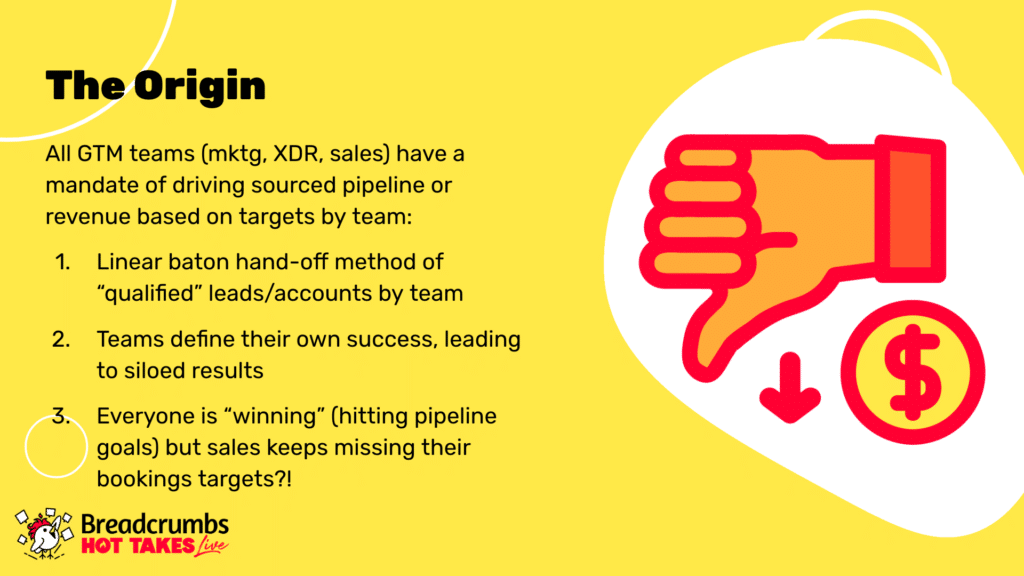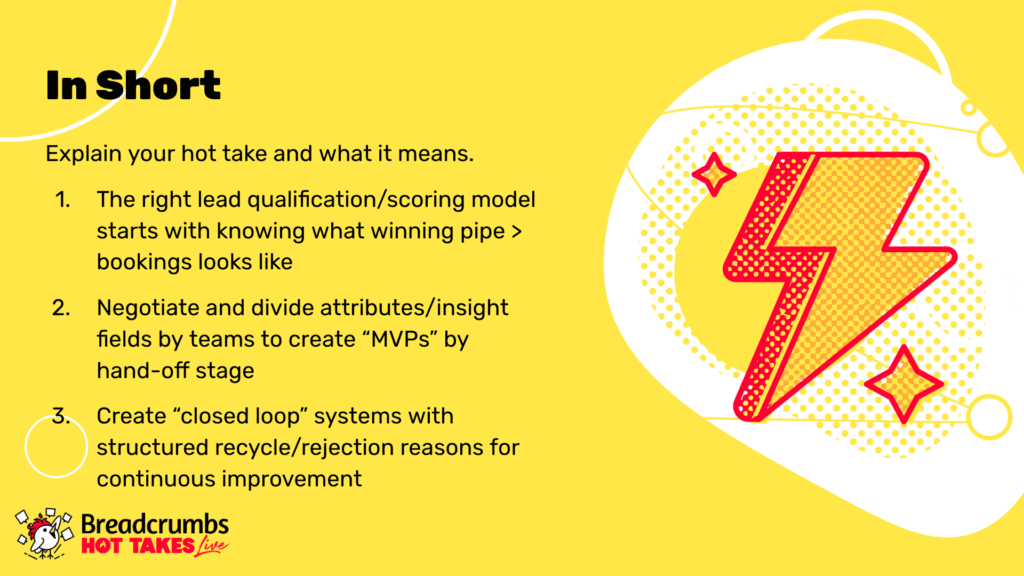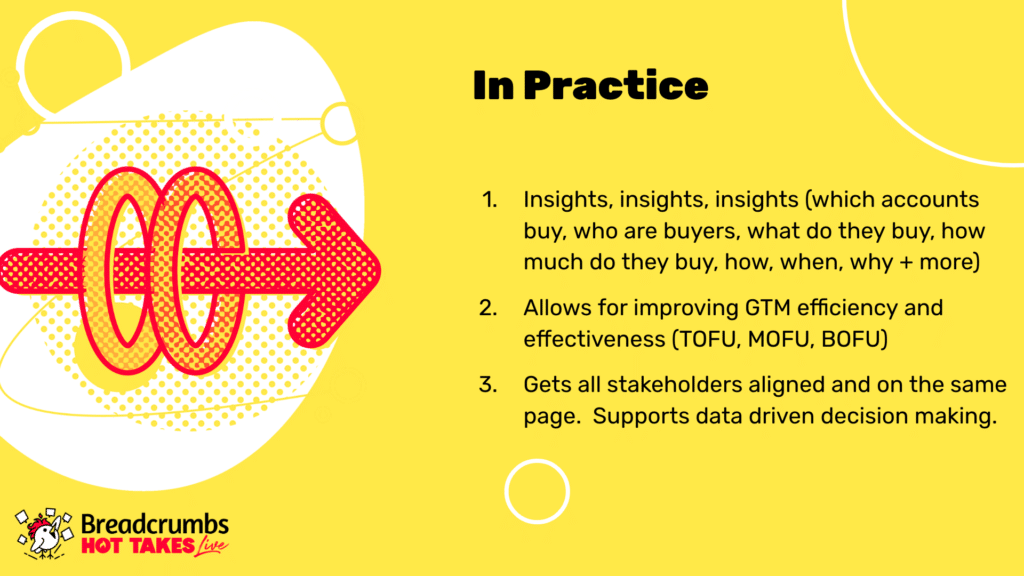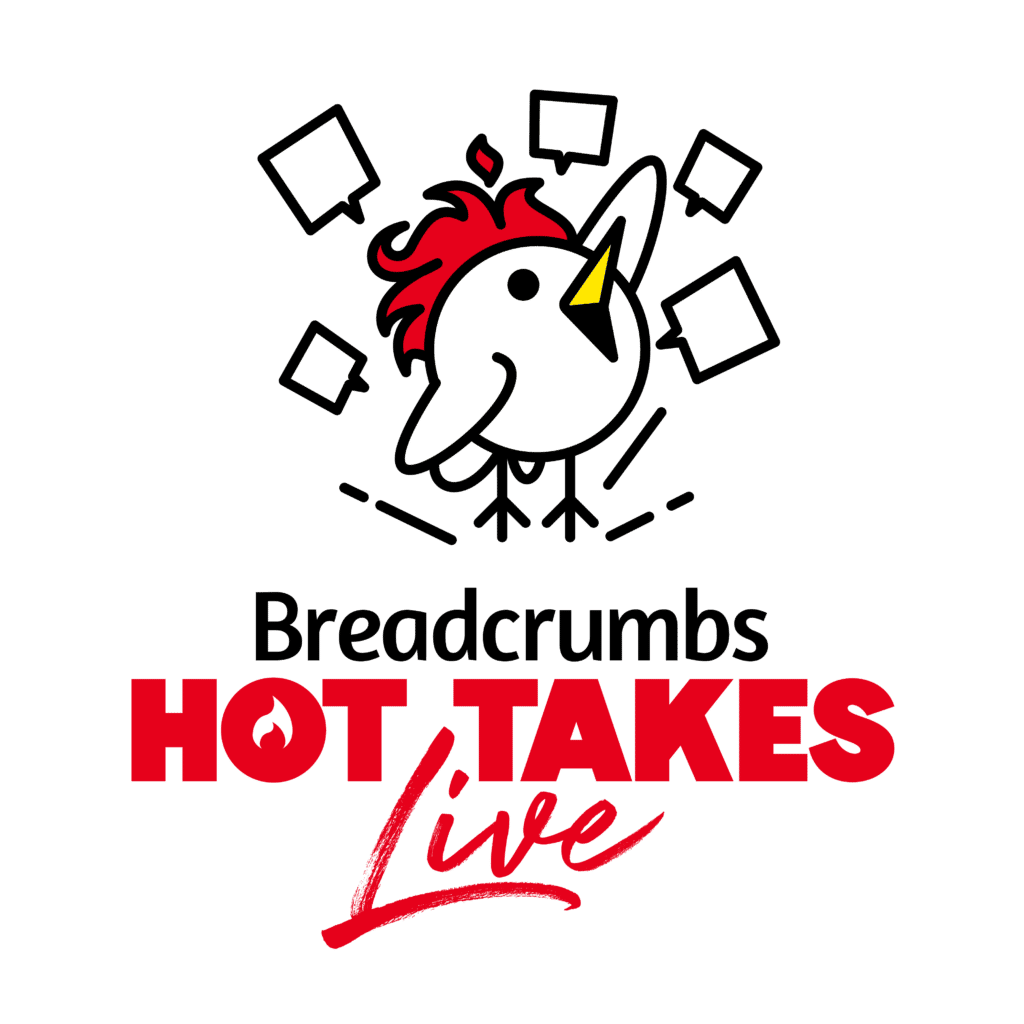Marketing teams invest a lot of money/time into creating sophisticated lead scoring models to hand off to SDRs.
Opportunities are then dispositioned by SDRs using their own defined methodology and handed off to Sales, who either accepts/rejects opportunities based on a sales methodology to work them into closed won deals.
This situation often leads to a common occurrence where all teams can meet or exceed their own targets but the overall business misses on bookings goals. The right solution starts when all teams are aligned to a common qualification methodology based on what attributes of winning opportunities look like in your sales CRM.
By aligning all teams around these winning attributes, GTM teams can qualify better, create standards for hand-offs to improve conversions, and ensure the pipeline for sales is “born on 3rd base” for the highest chances of conversion to bookings.
Listen in as Kenny Lee, VP of Revenue Marketing at Seismic, explains why your lead scoring model is wrong. Well, maybe not so much wrong, but how it could be better.
[Transcript] Your Lead Scoring Model is Wrong
Although transcriptions are generally very accurate, just a friendly reminder that they could sometimes be incomplete or contain errors due to unclear audio or transcription inaccuracies.
Armando Biondi
Kenny, you are our next speaker! Kenny Lee, VP of Revenue Marketing at Seismic. We cannot wait for the topic of this one, for obvious reasons.
Your lead scoring model is wrong. That’s your hot take. Take it away!
Kenny Lee
All right, hi, everyone! Thanks so much, Armando, for having me on board. I’m really, really excited to be here; thought I would start off by making this provocative statement, “Your lead scoring model is wrong.” Maybe not so much wrong, but how it could be better.
I’m gonna just share a little quick tidbit about myself. I’m the VP of Revenue Marketing at Seismic; we’re the leader in enablement.
Just a quick, interesting fact about me is that I love adventure travel. I’ve been to the top of Mount Whitney, which is the highest point in continental U.S., and also to the top of Mount Fuji, Kilimanjaro, Machu Picchu, and Everest base camp. The funny thing, Armando, is that I am scared of heights, so not sure why I’m putting myself through this.
I want to share just my quick story: so every company that I’ve worked at for the past 15 years they have a go-to-market model that I think everyone is familiar with. You have marketing creating demand, or they drive leads or qualified accounts, and they pass those leads or accounts off to an inside sales team, be it an SDR or BDR team.

They further qualify it and hopefully turn them into a meeting or a demo that goes to their sales rep. Then everyone holds their breath waiting for the sales rep to either accept or reject that opportunity and then turn it into pipeline, and then there’s a whole accreditation; you owe this much in pipeline by this team, that team, and that team, and that’s where the attribution happens.
One thing I noticed time and time again in a lot of the companies that I’ve been at is that each marketing team or inside sales team or sales teams they’ll work in their own silo. They’ll create their own methodology for what success looks like. So, for example, many of us in marketing will create our own definition for what is an MQL or a marketing-qualified account; we might use out-of-the-box scoring or popular third-party ABM software with intent signals to tell us that.
Whatever it is, we’ll define what we think a qualified handoff is to an XDR; the BDRs or SDRs will use the same methodology; they might have their own method: take whatever marketing provides and then apply their qualification lens, maybe it’s BANT, maybe it’s Sandler, it’s some type of methodology and this sounds crazy but I’ve been in companies where sales will then look at that and then based on their own methodology maybe they’re using a custom form of Challenger or Taz training, they’ll apply that.
Often, what happens over time is that each team, because all of us in tech are generally capable people, we find a way to hit our defined metrics on a consistent basis.
So what happens is marketing will say, “Well, I hit my goals or my handoff targets,” or they’ll try to hit their pipeline goals. Yet, the conversion rates between different teams will be really low, it’s hard to be predictable, and ultimately sales will keep missing their bookings targets.
There’s a saying that often happens, which is if marketing is hitting their pipeline goals, but sales is missing their numbers, you can’t give each other high fives on the marketing team because something isn’t working.
This is something that happens on a regular basis that I’ve seen in different places that I’ve been, and then companies go back to keep tweaking their own siloed goals, so that’s what happens.
My hot take and what I’ll say is that ultimately if marketers want to build the right lead qualification model, you have to know what winning pipeline that consistently converts to bookings in the quarter that was intended should look like.
Meaning that, basically, you look at what’s happening on the sales side to see and get insights into helping you build your lead scoring model.
So how do you do this? I think there are two ways. One is the easy way which is you call Armando and you say show me a demo of Breadcrumbs, or you do what I did as I didn’t know about Breadcrumbs at the time.
Ready to accelerate your revenue?
Start closing better deals faster, expanding into your customer base and holding on to customers longer (we do retention too)!
We did the hard thing by hiring a third-party consultant to come and take every opportunity in Salesforce that we won for the past two years and lost, and we brute force downloaded every selection field.
We then took those fields and mapped those fields to key conditions like what the converts were like: high conversion rates, high-velocity, low conversion rates, or high conversions. We looked at basically all these different attributes, and then we applied that to a scatter graph where we looked at where there were clusters of opportunities.
Once we did that, we applied a decision tree analysis with the consultant. They identified patterns of recognition that said, “Hey, look, these are the type of fields or the type of selections that win more versus lose more,” and we started to identify these different things that started to come out.
As we identified these opportunities, we then came up with a profile of key attributes of what a winning pipeline that was consistently closing looked like, and then you could take that back to your marketing teams, your inside sales teams, and sales and negotiate which of those different attributes make the best sense for the different teams to qualify and disposition.

If you build that structure in place or what I call minimum viable handoff stages, you can start to better track where you might have challenges or opportunities in your funnel.
By doing this, you also create what I call a system of closed-loop systems to be able to track clear recycle and rejection reasons, why things move forward or they don’t, all in the spirit of continuously improving why things are moving faster, why things are getting clogged up.
The next point that I want to say is how did this approach influence our overall strategy?
Well, number one, it helped us really answer which accounts are buying, who the buyers are in this process, what do they buy, how much do they buy, how and when, and so much more information.

This was great information to help us further hone in on how we qualify so that we can actually improve our go-to-market efficiency and really understand, basically, how do we start increasing velocity through the customer journey.
I think it’s obvious to say that the customer journey isn’t a linear process. You see where people come forward, where they go backward, and how different buying teams operate. This will help you understand basically where people are along that journey to figure out who should best qualify or who should best get ahead of asking the right questions at the right different stages.
Ultimately, it’s all about getting stakeholders aligned on the same page, and so I’m gonna say that to wrap up my point: ultimately, if you want to know what the winning pipeline and the bookings look like, analyze that and then get all your go-to-market teams aligned to those attributes and figure out how to divide those and conquer, so that’s it.

Hot Takes Live
Replays
Catch the replay of Hot Takes Live, where 30 of the top SaaS leaders across Marketing, Sales, and RevOps revealed some of their most unpopular opinions about their niche.
These leaders shared what lessons they learned and how they disrupted their industry by going against the grain (and achieved better results in the process).
Armando Biondi
Kenny, love it! Oh my! All right, so it’s funny because you went through very quickly a lot of stuff with regard to how to think through a high-performing, highly effective scoring engine for your company, and I think it’s one of the reasons we created Breadcrumbs, which is a scoring model manager, so let’s get that out of the way. And so, a lot of that stuff that we do have to do with that.
But the interesting thing that I wanted to unpack a little with you is the fact that most companies don’t think like that. Most companies are like, “Oh yeah, sure, let’s do a scoring system, let’s do plus 10 whenever like an email open, minus five whenever that other thing happens. What got you guys to think in this more sophisticated way?
Kenny Lee
So I have been, I jokingly say, fortunate to work at some companies that didn’t have product-market fit and that were not a leader in their space. We were selling a product or a solution that was way ahead of market maturity, and so you can’t wait for the phone to ring and look at how to harvest that demand.
I think traditional demand models where you have that sausage factory or baton handoff work when everyone’s in a buying mood, everyone’s got money, and they want to test and iterate. When I was working in companies that didn’t have that recognition, you have to pull the market forward. No one’s answering your phone, and no one’s buying, so you really have to look at what works and what doesn’t work and figure out what are the right qualifiers that really we should be going afterward.
Even if we keep saying, “Look, we’re building pipeline, but it’s not closing,” or it keeps being pushed out to the next quarter and the next quarter, the next quarter, you’re just wasting money. Given those constraints, we have to figure out, “Okay, let’s re-look at everything; let’s really work together.”
The hardest thing, Armando, was negotiating or understanding what’s actually working and what’s not, but then looking to sales to help us get those insights and then discussing with our inside sales and marketing teams what the capability is to qualify and when we should qualify.
Not an easy process, but again would never have done that if it was a product that was easy to sell that had momentum because you’re just managing a run rate versus really pulling demand in.
Armando Biondi
Yeah, absolutely, and one of the things that you were mentioning as the hardest one of the hardest part is the negotiation/alignment aspect. How do you navigate that?
Kenny Lee
Very carefully, with empathy. A lot of it too depends on the skillset. You know how much you can expect, for example, from a relatively Junior Inbound or an SDR team or an XRD team to qualify.
One example I think about was when I was at this company, Lithium, we were selling a six-figure B2B Enterprise SaaS solution that was ahead of market maturity. Number one, we had to assess whether our inside sales teams could really ask the right type of qualification questions that will essentially get our pipeline stage one born on third base.
We figure it out, for example, look, there was a certain set of qualifying fields that in stage one a sales rep would ask, so how do we actually make sure that we fulfill between marketing and inside sales 40% of those or 50% of those? Sales would like 100% of all those qualification fields met, but we had to discuss with sales teams to figure out do we need a training plan or not; if we needed to layer in technology to help us find additional insights about that stage one opportunity.
I always say, “How do I get my sales pipeline born on third base?” It’s already ready to go, and that’s just getting together in a room to figure that out
Armando Biondi
For sure, and one thing I wanted to unpack that you touched on quickly as well is that measurement aspect. I think it’s kind of a common denominator to lots of the stuff that you talked about, but I think it’s worth unpacking further.
How do you measure success?
Kenny Lee
Overall the biggest thing for me, my starting point was that in some of the companies that I’ve been at, the marketing to inside sales handoff was less than 5% I was able to get it to 30% marketing to sales handoff.
So number one you dramatically reduce the volume of leads or accounts that you need because you’re able to drive more efficient conversion. At the end of the day, you look at pipeline as another metric but also basically the ability for that to turn into bookings in totality versus each individual team and that was a major shift.
The other thing that I’ll tell you is an insight, Armando, that we learned was that in this process, old school mentality was, “Hey, marketing’s not doing their job,” or “Inside sales is dropping the ball.” In this process where we all agree on the handoff stages, what it would look like, sales going through their process, we actually learned that a lot of it was product shortcomings.
We’re not paying pointing fingers, we’re just saying look we’re losing customers at stage two because there’s product gaps, and here’s the data that tells us that.
So in the past you have a lot of anecdotes where every team trying to figure out their own way to improve things and it’s hard to know, but here when you have it and this is why I say it’s a closed loop model. More quickly figure out how to diagnose these challenges.
Those were some of the metrics that I think about, what we were seeing in some of the different companies that I’ve been at, that I’ve been able to implement in whole or parts of this.
Armando Biondi
So when you say feedback loop model or like system that is really like a feedback loop into how the funnel is behaving and then comparing that with best practices and benchmarks so that you can get a sense of you know points of leverage where to focus on with regards to hey this is an area of improvement that we could tackle.
Kenny Lee
Yes, exactly.
Armando Biondi
Interesting. Well, this has been awesome, Kenny thank you so much very excited to have you part of this hot takes live.
If anyone wants to connect further with Kenny they can find you on LinkedIn.
Kenny Lee
Find me on LinkedIn, I always love chatting about this kind of stuff. I have visuals, if people want to walk through things happy to do that.
Armando Biondi
I have one more question actually before wrapping up since we have 60 seconds more. What is revenue marketing and how is different from marketing?
Kenny Lee
Revenue marketing to me looks not just at traditional pipeline generation or overall broad demand generation. Revenue marketing really looks at what are all the ways that marketing can get involved in pre-pipeline, in-pipeline, and post-pipeline and customer marketing to look at a total portfolio of how to drive the business forward.
Armando Biondi
So not only top of the funnel but middle and bottom of the funnel as well.
Kenny Lee
Middle and bottom, and ultimately the goal is revenue, it’s not pipeline because again, in this model, I’ve been at a lot of companies Armando where I jokingly say there are pipe laundering factories: pipeline goes in, flushed out, gets pushed out.
No one knows what happened, and if you’re spending money on it you got to know actually how efficient.
Armando Biondi
Where is it going? What is it doing, or otherwise, what’s the point?
Love it, Kenny! Thank you so much.
